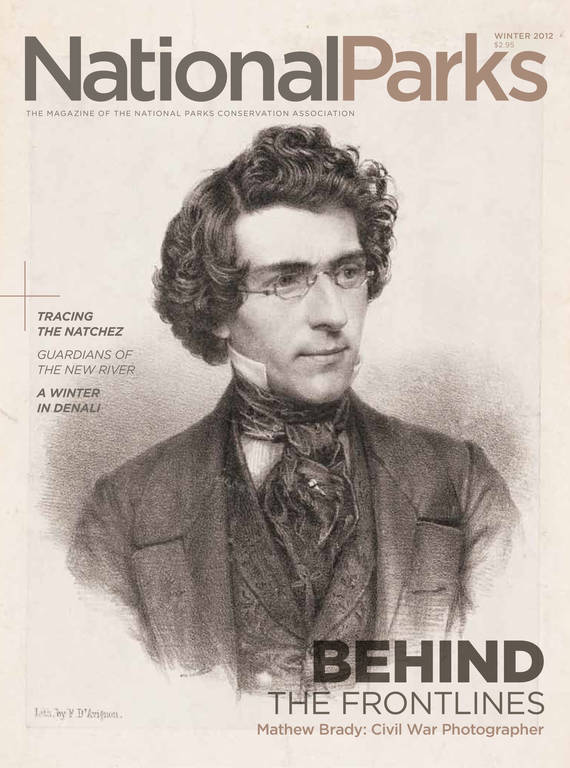Winter 2012
In Harm’s Way
NPCA moves to prevent fracking near Delaware Water Gap until likely impacts are revealed.
Sean McGuinness has experienced fracking in action—but only from a distance. Still, the Superintendent of the Upper Delaware Scenic and Recreational River could clearly see, hear, smell, and taste the impact of chemically treated water being forcefully pumped into underground rock to create fissures that allow the release of natural gases.
“There were huge pits in people’s backyards, the countryside was dotted with pipes, the roads were all chewed up,” he says, describing the industrialization taking over farmland in Bradford County, far across the state from the park unit under his care. The noise, odor, and dust was persistent, McGuinness recalls. “I was horrified that this might come to our basin.”
Thanks to the presence of a 400-million-year old geological formation known as the Marcellus Shale, which spreads some 48,000 square miles under seven states, the possibility is a very real threat. Fracking operations, or hydraulic fracturing, typically involve hundreds of trucks—and often require the construction of new roads. For days, trucks move back and forth between nearby rivers to transport water to the drill site. This water is then mixed with sand and chemical agents to create fracturing fluid. After drillers reach the shale, which can sit more than a mile underground, a charge (similar to a rifle shot) is set to fracture it. The fracking mix is then injected under high pressure to break open the formation, and allow the natural gas to flow to the well head.
Although fracking has been conducted in Pennsylvania for a few years, the Delaware River Basin Commission (DRBC) has imposed a moratorium on fracking in its region since May 2010. The moratorium will remain in place until the commission, made up of the U.S. Army Corps of Engineers and the governors of Delaware, New Jersey, New York, and Pennsylvania, develops and adopts specific regulations governing the extraction of gas. Enter NPCA. Insisting that federal law requires substantial environmental impact studies be completed before such regulations are even introduced, a coalition of groups, including NPCA, filed suit against the commission and the Corps this summer.
At issue is a better understanding of just what havoc fracking can wreak. The technique has been blamed for everything from earthquakes to habitat disruption, and dramatic video from documentaries like “Gasland” has even shown nearby residents lighting their water on fire. After spills occurred in Bradford County, water wells in the area were found to be contaminated.
“All we’re saying is that the public is entitled to know what will happen if this project is implemented,” says Susan Kraham, senior staff attorney at Columbia University’s Environmental Law Clinic, the law team for the plaintiffs. Among other things, an environmental impact study would look at the effects of well-pad construction, the likelihood of habitat destruction, and the presence of chemical particulates in potable water.
There’s no doubt that fracking makes its presence felt, in one way or another, even as the natural gas industry offers promises of weaning Americans from dependence on foreign oil. But for the region’s national parks—some 35 overlie or are in the Marcellus vicinity—the effects could be especially keen. “We’re really concerned with the water quality and air quality in the national parks in the region,” says Cinda Waldbuesser, senior program manager for NPCA’s Pennsylvania field office. “If that’s degraded, we’ll really notice it in everything from the water that visitors raft in, to the migration patterns of wildlife like black bear and bald eagles, to the quality of our night skies.”
According to McGuinness, the companies involved have promised they will install well pads no larger than seven acres, and do so on areas that are already cleared of trees. But, he adds, 80 percent of land in the Basin is still forest, so there’s a good chance more land will come under attack. “Every well pad requires cutting down trees, plowing roads through the forest, and then clearing other corridors so pipelines can connect the pads and transport the gas,” he notes.

National Parks
You can read this and other stories about history, nature, culture, art, conservation, travel, science and more in National Parks magazine. Your tax-deductible membership donation of $25 or more entitles…
See more ›Despite the suit, DRBC is planning to vote on the regulation soon. “At first, the regulations included some very strong wording around issues of land- and resource-protection,” says McGuinness, who reviewed drafts throughout the process. “They addressed the siting of the well pads, they addressed water-quality issues, and where chemicals would be stored and how they would be handled. They even anticipated worst-case scenarios such as spillages.” Unfortunately, as the DRBC members reviewed and edited the proposal over the last year, the regulations were significantly weakened, and the agency refused to open the newest version to public comment, even though the public had submitted thousands of comments in response to a previous draft.
It all leads Kraham to predict a protracted fight. “Once some form of the regulations are adapted, the applications to drill will start pouring into the DRBC for approval,” she comments, “and we don’t know how long all of that will take.” Litigation will continue to address whatever regulations are ultimately adapted, Kraham is certain.
“We want to be clear: NPCA is not against natural-gas development,” says Waldbuesser. “We recognize the economic benefits associated with these projects. But they shouldn’t compromise those benefits offered by the national parks. These are heavily visited areas that generate tremendous income, too. We simply want to make sure that we understand the impacts before we move forward. At that point, we can take steps to ensure that these natural resources are adequately protected.”



